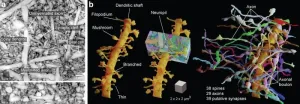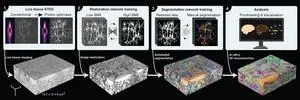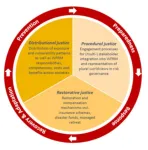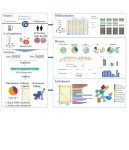(Press-News.org) Brain tissue is one of the most intricate specimens that scientists have arguably ever dealt with. Packed with currently immeasurable amount of information, the human brain is the most sophisticated computational device with its network of around 86 billion neurons. Understanding such complexity is a difficult task, and hence making progress requires technologies to unravel the tiny, complex interactions taking place in the brain at microscopic scales. Imaging is therefore an enabling tool in neuroscience.
The new imaging and virtual reconstruction technology developed by Johann Danzl’s group at ISTA is a big leap in imaging brain activity and is aptly named LIONESS – Live Information Optimized Nanoscopy Enabling Saturated Segmentation. LIONESS is a pipeline to image, reconstruct, and analyze live brain tissue with a comprehensiveness and spatial resolution not possible until now.
“With LIONESS, for the first time, it is possible to get a comprehensive, dense reconstruction of living brain tissue. By imaging the tissue multiple times, LIONESS allows us to observe and measure the dynamic cellular biology in the brain take its course,” says first author Philipp Velicky. “The output is a reconstructed image of the cellular arrangements in three dimensions, with time making up the fourth dimension, as the sample can be imaged over minutes, hours, or days,” he adds.
With LIONESS neuroscientists can image living brain tissue
and achieve high-resolution 3D imagery
without damaging the living sample.
Collaboration and AI the Key
The strength of LIONESS lies in refined optics and in the two levels of deep learning – a method of Artificial Intelligence – that make up its core: the first enhances the image quality and the second identifies the different cellular structures in the dense neuronal environment.
The pipeline is a result of a collaboration between the Danzl group, Bickel group, Jonas group, Novarino group, and ISTA’s Scientific Service Units, as well as other international collaborators. “Our approach was to assemble a dynamic group of scientists with unique combined expertise across disciplinary boundaries, who work together to close a technology gap in the analysis of brain tissue,” Johann Danzl of ISTA says.
Surpassing hurdles
Previously it was possible to get reconstructions of brain tissue by using Electron Microscopy. This method images the sample based on its interactions with electrons. Despite its ability to capture images at a few nanometers—a millionth of a millimeter—resolution, Electron Microscopy requires a sample to be fixed in one biological state, which needs to be physically sectioned to obtain 3D information. Hence, no dynamic information can be obtained.
Another previously known technique of Light Microscopy allows observation of living systems and record intact tissue volumes by slicing them “optically” rather than physically. However, Light Microscopy is severely hampered in its resolving power by the very properties of the light waves it uses to generate an image. Its best-case resolution is a few hundred nanometers, much too coarse-grained to capture important cellular details in brain tissue.
Using Super-resolution Light Microscopy scientists can break this resolution barrier. Recent work in this field, dubbed SUSHI (Super-resolution Shadow Imaging), showed that applying dye molecules to the spaces around cells and applying the Nobel Prize-winning super-resolution technique STED (Stimulated Emission Depletion) microscopy reveals super-resolved ‘shadows’ of all the cellular structures and thus visualizes them in the tissue. Nevertheless, it has been impossible to image entire volumes of brain tissue with resolution enhancement that matches the brain tissue’s complex 3D architecture. This is because increasing resolution also entails a high load of imaging light on the sample, which may damage or ‘fry’ the subtle, living tissue.
Herein lies the prowess of LIONESS, having been developed for, according to the authors, “fast and mild” imaging conditions, thus keeping the sample alive. The technique does so while providing isotropic super-resolution—meaning that it is equally good in all three spatial dimensions—that allows visualization of the tissue’s cellular components in 3D nanoscale resolved detail.
LIONESS collects only as little information from the sample as needed during the imaging step. This is followed by the first deep learning step to fill in additional information on the brain tissue’s structure in a process called Image Restoration. In this innovative way, it achieves a resolution of around 130 nanometers, while being gentle enough for imaging of living brain tissue in real-time. Together, these steps allow for a second step of deep learning, this time to make sense of the extremely complex imaging data and identify the neuronal structures in an automated manner.
Homing In
“The interdisciplinary approach allowed us to break the intertwined limitations in resolving power and light exposure to the living system, to make sense of the complex 3D data, and to couple the tissue’s cellular architecture with molecular and functional measurements,” says Danzl.
For virtual reconstruction, Danzl and Velicky teamed up with visual computing experts: the Bickel group at ISTA and the group led by Hanspeter Pfister at Harvard University, who contributed their expertise in automated segmentation—the process of automatically recognizing the cellular structures in the tissue—and visualization, with further support by ISTA’s image analysis staff scientist Christoph Sommer. For sophisticated labeling strategies, neuroscientists and chemists from Edinburgh, Berlin, and ISTA contributed. Consequently, it was possible to bridge functional measurements, i.e. to read out the cellular structures together with biological signaling activity in the same living neuronal circuit. This was done by imaging Calcium ion fluxes into cells and measuring the cellular electrical activity in collaboration with the Jonas group at ISTA. The Novarino group contributed human cerebral organoids, often nicknamed mini-brains that mimic human brain development. The authors underline that all of this was facilitated through expert support by ISTA’s top-notch scientific service units.
Brain structure and activity are highly dynamic; its structures evolve as the brain performs and learns new tasks. This aspect of the brain is often referred to as “plasticity”. Hence, observing the changes in the brain’s tissue architecture is essential to unlocking the secrets behind its plasticity. The new tool developed at ISTA shows potential for understanding the functional architecture of brain tissue and potentially other organs by revealing the subcellular structures and capturing how these might change over time.
END
LIONESS redefines brain tissue imaging
Large collaboration at ISTA yields an unprecedented “live” view into the brain's complexity
2023-07-10
ELSE PRESS RELEASES FROM THIS DATE:
Racial, ethnic differences in factors associated with delayed or missed pediatric preventive care due to the pandemic
2023-07-10
About The Study: In this cross-sectional study, more than one-fourth of children had delayed or missed preventive care due to the COVID-19 pandemic. These findings may guide targeted interventions to enhance timely pediatric preventive care among different racial and ethnic groups.
Authors: Maya Tabet, Ph.D., M.S., of the University of Health Sciences and Pharmacy in St. Louis, is the corresponding author.
To access the embargoed study: Visit our For The Media website at this link https://media.jamanetwork.com/
(doi:10.1001/jamanetworkopen.2023.22588)
Editor’s ...
Association between pandemic and early childhood development
2023-07-10
About The Study: The findings of this study showed an association between exposure to the COVID-19 pandemic and delayed childhood development at age 5. Variations in development widened during the pandemic regardless of age. It is important to identify children with developmental delays associated with the pandemic and provide them with support for learning, socialization, physical and mental health, and family support.
Authors: Koryu Sato, M.P.H., of Kyoto University in Kyoto, Japan, is the corresponding author.
To access the embargoed ...
Prevalence, trends in diagnosed learning disability among US children and adolescents
2023-07-10
About The Study: Based on U.S. nationally representative data, the estimated learning disability prevalence was 8.83% among children and adolescents ages 6 to 17 from 1997 to 2021, which was slightly higher than that from a previous National Health Interview Survey study from 2009 to 2017 (7.74%). These data indicate that learning disability is a common chronic condition among U.S. children, affecting about 9 in 100 overall. In this population-based study, no significant annual change was found.
Authors: Wenhan ...
In-person mindfulness courses help improve mental health for at least six months, study shows
2023-07-10
PRESS RELEASE FROM THE UNIVERSITY OF CAMBRIDGE
EMBARGOED UNTIL 16:00 LONDON TIME (GMT) ON MONDAY 10 JULY 2023
Paper available at: https://drive.google.com/drive/folders/1TzS8tT1_Z4knsHs38gp4LOlLKiPvOUEy?usp=sharing
In-person mindfulness courses help improve mental health for at least six months, study shows
Adults who voluntarily take part in mindfulness courses are less likely to experience symptoms of anxiety and depression for at least six months after completing the programmes, compared to adults who do not take ...
Abatacept, cenicriviroc, or infliximab for treatment of adults hospitalized with COVID-19 pneumonia
2023-07-10
About The Study: This randomized clinical trial found that treatment with abatacept, cenicriviroc, or infliximab showed no significant difference of time to recovery compared with placebo for patients hospitalized with COVID-19 pneumonia.
Authors: William G. Powderly, M.D., of the Washington University School of Medicine in St. Louis, is the corresponding author.
To access the embargoed study: Visit our For The Media website at this link https://media.jamanetwork.com/
(doi:10.1001/jama.2023.11043)
Editor’s Note: Please see the article for additional information, including other authors, author contributions and affiliations, conflict of interest ...
Addressing justice in wildfire risk management
2023-07-10
The frequency and severity of wildfires have become increasingly alarming in recent years, substantially due to the effects of climate change. Rising global temperatures, altered weather patterns, and prolonged droughts are all consequences of climate change that contribute to the heightened risk of wildfires.
The 2019-2020 Australian wildfires demonstrated that compound climatic events – long-lasting record high temperatures combined with record low precipitation – can lead to unprecedented ...
Photonic snake states
2023-07-10
This study has attracted the attention of the international scientific community and opens up unprecedented perspectives in the formation of frequency combs: it predicts the existence of two-dimensional optical rules, more complex than the one-dimensional ones used so far and offering unprecedented versatility in a wide range of applications.
Applications in communications, spectroscopy, or computing
Frequency combs have a wide range of applications, particularly in the field of communications. According to the authors of the study, these combs allow large amounts of information to be transmitted through optical fibres in a ...
More menu choices: Migrant orangutans learn a lot about food by watching the locals
2023-07-10
Orangutans are dependent on their mothers longer than any other non-human animal, nursing until they are at least six years old and living with her for up to three more years, learning how to find, choose, and process the exceedingly varied range of foods they eat. But how do orangutans that have left their mothers and now live far from their natal ranges, where the available foods may be very different, decide what to eat and figure out how to eat it? Now, an international team of authors has shown that in such cases, migrants follow the rule ‘observe, and do as the locals do’.
“Here we show evidence that migrant orangutan males ...
Chinese Medical Journal study presents new database linking RNA editing and blood cell differentiation
2023-07-10
The process of converting DNA to proteins through an RNA is far from straightforward. Of the several types of RNA involved in the process of protein synthesis, a few may be edited mid-way. In mammals, RNA editing mostly involves converting adenosine (A) to inosine (I) through deamination, which can result in a wide range of effects. For example, A-to-I conversion can regulate gene expression in different ways and significantly alter the final synthesized protein.
While RNA editing is an essential biological process, it is also a key underlying mechanism in some diseases, including cancer. Thus, scientists have created large-scale databases documenting RNA editing sites in various human ...
Microbial predators cause seasonal fluctuations in wastewater treatment
2023-07-10
The community of microbial predators influences the composition of the bacterial community in wastewater. This explains seasonal variations in the microbial community that affect the efficiency of water treatment. This is the result of a study conducted by Nils Heck and PD Dr Kenneth Dumack from the University of Cologne’s Institute of Zoology. The study has been published under the title ‘Microeukaryotic predators shape the wastewater microbiome’ in the journal Water Research.
In wastewater treatment plants, a precisely coordinated interaction of different microorganisms takes place in order to effectively ...
LAST 30 PRESS RELEASES:
Why nail-biting, procrastination and other self-sabotaging behaviors are rooted in survival instincts
Regional variations in mechanical properties of porcine leptomeninges
Artificial empathy in therapy and healthcare: advancements in interpersonal interaction technologies
Why some brains switch gears more efficiently than others
UVA’s Jundong Li wins ICDM’S 2025 Tao Li Award for data mining, machine learning
UVA’s low-power, high-performance computer power player Mircea Stan earns National Academy of Inventors fellowship
Not playing by the rules: USU researcher explores filamentous algae dynamics in rivers
Do our body clocks influence our risk of dementia?
Anthropologists offer new evidence of bipedalism in long-debated fossil discovery
Safer receipt paper from wood
Dosage-sensitive genes suggest no whole-genome duplications in ancestral angiosperm
First ancient human herpesvirus genomes document their deep history with humans
Why Some Bacteria Survive Antibiotics and How to Stop Them - New study reveals that bacteria can survive antibiotic treatment through two fundamentally different “shutdown modes”
UCLA study links scar healing to dangerous placenta condition
CHANGE-seq-BE finds off-target changes in the genome from base editors
The Journal of Nuclear Medicine Ahead-of-Print Tip Sheet: January 2, 2026
Delayed or absent first dose of measles, mumps, and rubella vaccination
Trends in US preterm birth rates by household income and race and ethnicity
Study identifies potential biomarker linked to progression and brain inflammation in multiple sclerosis
Many mothers in Norway do not show up for postnatal check-ups
Researchers want to find out why quick clay is so unstable
Superradiant spins show teamwork at the quantum scale
Cleveland Clinic Research links tumor bacteria to immunotherapy resistance in head and neck cancer
First Editorial of 2026: Resisting AI slop
Joint ground- and space-based observations reveal Saturn-mass rogue planet
Inheritable genetic variant offers protection against blood cancer risk and progression
Pigs settled Pacific islands alongside early human voyagers
A Coral reef’s daily pulse reshapes microbes in surrounding waters
EAST Tokamak experiments exceed plasma density limit, offering new approach to fusion ignition
Groundbreaking discovery reveals Africa’s oldest cremation pyre and complex ritual practices
[Press-News.org] LIONESS redefines brain tissue imagingLarge collaboration at ISTA yields an unprecedented “live” view into the brain's complexity





